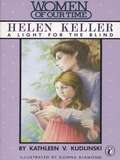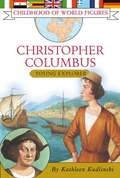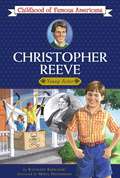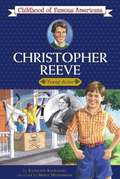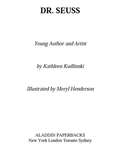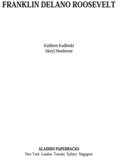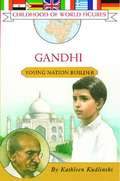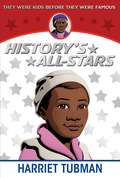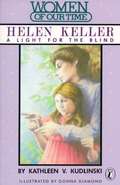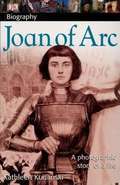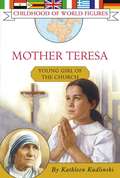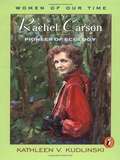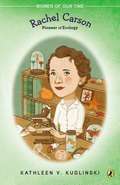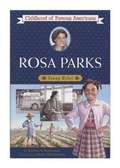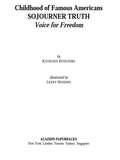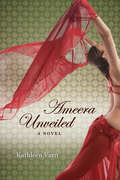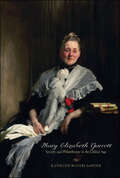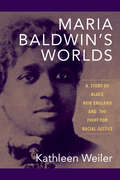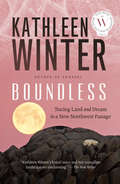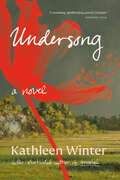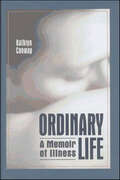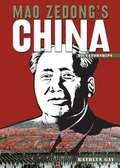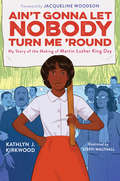- Table View
- List View
Helen Keller
by Kudlinski Kathleen V.If Alfred I. du Pont was born to "the purple and ermine" of an American industrial dynasty, his life was far from peaceful, pampered, indolent. Beginning at the bottom as little more than a teamster and handyman, within fifteen years young du Pont was widely recognized as "the best black powderman in the nation" and the mechanical genius of the du Pont family. In 1902, upon the death of Eugene du Pont, Alfred was brash and confident enough to claim for himself the company his elders wanted to sell to their major competitor, Laflin and Rand. With two cousins, he formed a triumvirate which ultimately converted the old gunpowder company into the great chemical empire it is today. In this brilliantly written, in-depth biography, Joseph Frazier Wall ranges from Pierre Samuel du Pont de Nemours's spectacular rise in pre-Revolutionary France, to the family's migration to America and the founding of the Du Pont Company in Wilmington, to Alfred's death in 1935, charting the growth of one of America's great industrial dynasties. We meet Henry du Pont, the conservative leader of the third generation (he favored candles over electric lights in the office), who organized the entire gunpowder industry; Lammot du Pont, the crown prince of the third generation, who died tragically in an explosion at the Repauno plant; Eugene du Pont, whom Wall describes as "a director without direction"; and a host of other du Pont men and women. But Alfred du Pont remains the center of the narrative. Wall details his rejuvenation of the family company after Eugene's death, the bitter family feud that followed his marriage to his cousin Alicia, the fifteen-year battle that he waged with some of the family's most powerful members (leading to his ouster from the company in 1916), and his brilliant second career in Florida (where he pioneered the development of sound banking, transportation, and the paper industry). This is the first biography of Alfred du Pont to appear in half a century. In preparing it, Wall had complete access both to Alfred's own papers in Florida as well as the vast collection of the du Pont archives in Wilmington. The result is a compelling story of one of America's most creative businessmen as well as an inside look at one of our most historically significant families.
Christopher Columbus: Young Explorer (Childhood of Famous Americans Series)
by Kathleen V. KudlinskiChristopher Columbus, who landed in the Americas in 1492, is considered one of the world's most famous explorers. This fascinating biography details Columbus's childhood, which shaped his adventurous spirit.
Christopher Reeve
by Kathleen V. Kudlinski Meryl HendersonChildhood of Famous Americans One of the most popular series ever published for young Americans, these classics have been praised alike by parents, teachers, and librarians. With these lively, inspiring, fictionalized biographies -- easily read by children of eight and up -- today's youngster is swept right into history.
Christopher Reeve: Young Actor (Childhood of Famous Americans Series)
by Kathleen V. KudlinskiA fictionalized biography of the childhood of the famous actor.
Dr. Seuss: Young Author and Artist (Childhood of Famous Americans Series)
by Kathleen V. KudlinskiBorn in Springfield, Massachusetts, Theodor Seuss Geisel (1904-1991) was destined to grow up to become the most beloved, bestselling children's book writer of all time. This biography explores the events of his childhood. Illustrations.
Franklin Delano Roosevelt: Champion of Freedom (Childhood of Famous Americans Series)
by Kathleen V. KudlinskiThis childhood biography of the 32nd president of the United States explores the events that shaped the tenacious character of a young Franklin Delano Roosevelt.
Gandhi: Young Nation Builder (Childhood of Famous Americans Series)
by Kathleen V. KudlinskiThis book narrates the fascinating early years and eventual accomplishments of the inspiring leader, Mahatma Gandhi, who is known as the Father of the Nation of India.
Harriet Tubman: Freedom's Trailblazer (Childhood of Famous Americans Series)
by Kathleen V. KudlinskiBorn into slavery, Harriet Tubman escaped at the age of 29, only to risk her life to help more than 300 other slaves escape using the Underground Railroad. Nicknamed "Moses," Harriet dedicated her life to the cause of abolition and the welfare of African Americans.
Helen Keller: A Light for the Blind
by Kathleen V. KudlinskiA biography detailing Helen Keller's adventurous life as she worked tirelessly to lead the way for handicapped people.
Joan of Arc
by Kathleen V. KudlinskiThe story of Joan, a young farm girl who became a Christian martyr after she heard voices encouraging her to secure the throne of France for its rightful heir.
Juliette Gordon Low: America's First Girl Scout
by Kathleen V. KudlinskiPresents a biography of the founder of the Girl Scout movement.
Mother Teresa: Friend to the Poor
by Kathleen V. KudlinskiBorn Agnes Gonxha Bojaxhiu in 1910, Mother Teresa grew up in a small war-torn town in Macedonia. The youngest of three children, Mother Teresa was called Gonxha, which means "flower bud," by her family because of her cheerful disposition. Mother Teresa's family were devoted Catholics who prayed every evening and went to church almost every day. By the time she was twelve years old, Mother Teresa knew she wanted to devote her life to helping the sick and poor. Mother Teresa is considered one of the world's greatest humanitarians. She was the recipient of the United States Medal of Honor and the Nobel Peace Prize, and was beatified by Pope John Paul II. This fascinating biography details Mother Teresa's childhood and proves that one person can make a difference in the world with love and faith.
Rachel Carson
by Kathleen V. KudlinskiRachel Carson--scientist, author, and environmentalist Rachel Carson was always fascinated by the ocean. As a child, she dreamed of it and longed to see it. As a young woman, she felt torn between her love for nature and her desire to pursue a writing career. Then she found a way to combine both. Rachel had a talent for writing and talking about science in a way that everyone could understand and enjoy. With her controversial book, Silent Spring, Rachel Carson changed the way we look at our planet. "Kudlinski has admirably captured the driving force of spirit of a shy but courageous woman in a succinct, respectful approach."--Booklist About the Women of Our Time series: International in scope, the Women of Our Time series of biographies cover a wide range of personalities in a variety fields. More than a history lesson, these books offer carefully documented life stories that will inform, inspire, and engage.
Rachel Carson: Pioneer of Ecology
by Kathleen V. KudlinskiRachel Carson was always fascinated by the ocean. As a child, she dreamed of it and longed to see it. As a young woman, she felt torn between her love for nature and her desire to pursue a writing career. Then she found a way to combine both. Rachel had a talent for writing and talking about science in a way that everyone could understand and enjoy. With her controversial book, Silent Spring, Rachel Carson changed the way we look at our planet.
Rosa Parks: Young Rebel (Childhood of Famous Americans Series)
by Kathleen V. KudlinskiA fictionalized biography of the woman who refused to give up her seat on a bus, leading eventually to the civil rights era.
Sojourner Truth: Voice for Freedom (Childhood of Famous Americans Series)
by Kathleen V. KudlinskiWhat do you do when you don't have a home or a family to call your own anymore? Eleven-year-old Abigail is not entirely sure how she'll find it, but after losing her mother to smallpox and her father to the sea, she knows that it is up to her to build a new life for herself and her little brother, Seth. But carving a future out of the harsh realities of life in Wiscasset, a nineteenth-century Maine seaport, proves difficult.
Ameera, Unveiled
by Kathleen VarnAt the age of forty-eight, happily remarried and retired from her legal assistant, gerbil wheel, Kat decides to break out of her shell and try her hand at belly dancing. What begins as a hobby leads her to filling a coveted spot in Palmetto Oasis Middle Eastern Dance Troupe. With less than eight weeks to prepare, Kat's thrown into a world of performing she is terrified to face, all leading to a week of giving lessons and performing in Jamaica. Traveling with eight glittery strangers, she forges deep bonds under outrageous circumstances at what they'd soon all discover was a clothing-optional resort. Struggling with paralyzing stage fright and searching for the deeper root of her fears, Kat feverishly seeks a way to release Ameera, her inner dance queen. By the end of the week, the audience is mesmerized by the powerful presence and synchronicity of women joined at the hip by scares and some glitter. Kat soon knows, with the help of eight sisters in dance, that she is finally part of a tribe, discovering an oasis to refresh her thirst to be a part of a circle of wome
Mary Elizabeth Garrett: Society and Philanthropy in the Gilded Age
by Kathleen Waters Sander&“[A] richly detailed biography of a formidable nineteenth-century woman who worked in a man&’s world to help women attain education, suffrage, and equality.&” —Journal of American History As youngest child and only daughter to B&O Railroad mogul John Work Garrett, Mary was bright and capable, well suited to become her father&’s heir apparent. But social convention prohibited her from following in his footsteps, a source of great frustration for the brilliant and strong-willed woman. Mary turned her attention instead to promoting women&’s rights, using her status and massive wealth to advance her uncompromising vision for women&’s place in the expanding United States. She contributed the endowment to establish the Johns Hopkins School of Medicine with two unprecedented conditions: that women be admitted on the same terms as men and that the school be graduate level, thereby forcing revolutionary policy changes at the male-run institution. Believing that advanced education was the key to women&’s betterment, she helped found and sustain the prestigious girls&’ preparatory school in Baltimore, the Bryn Mawr School. Her philanthropic gifts to Bryn Mawr College helped transform the modest Quaker school into a renowned women&’s college. She was also a great supporter of women&’s suffrage. Kathleen Waters Sander recounts in impressive detail the life and times of this remarkable woman, through the turbulent years of the Civil War to the early twentieth century. At once a captivating biography of Garrett and an epic account of the rise of commerce, railroading, and women&’s rights, Sander&’s work is the first to recognize her monumental contributions to America while also reexamining the great social and political movements of the age.
Mary Elizabeth Garrett: Society and Philanthropy in the Gilded Age
by Kathleen Waters SanderA captivating look at the remarkable life of this nineteenth-century suffragist, philanthropist, and reformer.Mary Elizabeth Garrett was one of the most influential philanthropists and women activists of the Gilded Age. With Mary's legacy all but forgotten, Kathleen Waters Sander recounts in impressive detail the life and times of this remarkable woman, through the turbulent years of the Civil War to the early twentieth century. At once a captivating biography of Garrett and an epic account of the rise of commerce, railroading, and women's rights, Sander's work reexamines the great social and political movements of the age.As the youngest child and only daughter of the B&O Railroad mogul John Work Garrett, Mary was bright and capable, well suited to become her father's heir apparent. But social convention prohibited her from following in his footsteps, a source of great frustration for the brilliant and strong-willed woman. Mary turned her attention instead to promoting women's rights, using her status and massive wealth to advance her uncompromising vision for women's place in the expanding United States. She contributed the endowment to establish the Johns Hopkins School of Medicine with two unprecedented conditions: that women be admitted on the same terms as men and that the school be graduate level, thereby forcing revolutionary policy changes at the male-run institution. Believing that advanced education was the key to women's betterment, she helped found and sustain the prestigious girls' preparatory school in Baltimore, the Bryn Mawr School. Her philanthropic gifts to Bryn Mawr College helped transform the modest Quaker school into a renowned women's college. Mary was also a great supporter of women's suffrage, working tirelessly to gain equal rights for women.Suffragist, friend of charitable causes, and champion of women's education, Mary Elizabeth Garrett both improved the status of women and ushered in modern standards of American medicine and philanthropy. Sander's thoughtful and informed study of this pioneering philanthropist is the first to recognize Garrett and her monumental contributions to equality in America.
Maria Baldwin's Worlds: A Story of Black New England and the Fight for Racial Justice
by Kathleen Weiler“This well-written biography of an intriguing black educator is strong on narrative, recovering Baldwin’s life from obscurity with sound scholarship” (Jeffrey Aaron Snyder, author of Making Black History).In the late nineteenth century, Maria Baldwin established a unique place for herself as a highly respected educator at a largely white New England school. She also used her social standing to advance the African American cause. As an activist, she carried on the radical spirit of the Boston area’s renowned abolitionists. In Maria Baldwin’s Worlds, Kathleen Weiler reveals both Baldwin’s victories and what fellow activist W. E. B. Du Bois called her “quiet courage” in everyday life, in the context of the wider black freedom struggle in New England.African American sociologist Adelaide Cromwell called Baldwin “the lone symbol of Negro progress in education in the greater Boston area” during her lifetime. Baldwin fought alongside more radical activists like William Monroe Trotter for full citizenship for fellow members of the black community. And, in her professional and personal life, she negotiated and challenged dominant white ideas about black womanhood.
Boundless: Tracing Land and Dream in a New Northwest Passage
by Kathleen WinterThe long-awaited follow up to Annabel and Kathleen Winter’s first work of narrative nonfiction.In 2010, bestselling author Kathleen Winter took a journey across the storied Northwest Passage, among marine scientists, historians, archaeologists, anthropologists, and curious passengers. From Greenland to Baffin Island and all along the passage, Winter bears witness to the new math of the melting North — where polar bears mate with grizzlies, creating a new hybrid species; where the earth is on the cusp of yielding so much buried treasure that five nations stand poised to claim sovereignty of the land; and where the local Inuit population struggles to navigate the tension between taking part in the new global economy and defending their traditional way of life.Throughout the journey she also learns from fellow passengers Aaju Peter and Bernadette Dean, who teach her about Inuit society, past and present. She bonds with Nathan Rogers, son of the late Canadian icon Stan Rogers, who died in a plane crash when Nathan was nearly four years old. Nathan’s quest is to take the route his father never travelled, except in his beloved song “The Northwest Passage,” which he performs both as anthem and lament at sea. And she guides us through her own personal odyssey, emigrating from England to Canada as a child and discovering both what was lost and what was gained as a result of that journey.In breathtaking prose charged with vivid descriptions of the land and its people, Kathleen Winter’s Boundless is a haunting and powerful story, and a homage to the ever-evolving and magnetic power of the North.
Undersong
by Kathleen Winter&“A stunning, spellbinding, poetic triumph." —Toronto Star From Giller-shortlisted author Kathleen Winter (author of the bestseller Annabel): A stunning novel reimagining the lost years of misunderstood Romantic Era genius Dorothy Wordsworth.When young James Dixon, a local jack-of-all-trades recently returned from the Battle of Waterloo, meets writer Dorothy Wordsworth, he quickly realizes he&’s never met another woman anything like her. In her early thirties at the time of the meeting, Dorothy has already lived a wildly unconventional life. As her famous brother William Wordsworth&’s confidante and creative collaborator—considered by some in their circle to be the secret to his success as a poet—she has carved a seemingly idyllic existence for herself, alongside William and his wife, in England&’s Lake District. One day, Dixon is approached by William to do some handiwork around the Wordsworth estate. At William&’s urging, he takes on more and more chores—and quickly understands that his real, unspoken responsibility is to keep an eye on Dorothy, who is growing frail and melancholic. The unlikely pair of misfits form a sympathetic bond despite the sometimes troubling chasm in social class between them, and soon Dixon is the quiet witness to everyday life in Dorothy&’s family and glittering social circle, which includes literary legends Samuel Coleridge, Thomas de Quincy, William Blake, and Charles and Mary Lamb. Through the fictional James Dixon—a gentle but troubled soul, more attuned to the wonders of the garden he faithfully tends than to vexing worldly matters—we step inside the Wordsworth family, witnessing their dramatic emotional and artistic struggles, hidden traumas, private betrayals and triumphs. At the same time, Winter slowly weaves a darker, complex &“undersong&” through the novel, one as earthy and elemental as flower and tree, gradually revealing the pattern of Dorothy's rich, hidden life—that of a woman determined, against all odds, to exist on her own terms despite societal norms. But the unsettling effects of Dorothy&’s tragically repressed brilliance take their toll, and when at last her true voice finally sings out, it is so searing and bright that Dixon, compelled equally by love and grief and fear, must make an impossible choice.
Ordinary Life: A Memoir of Illness
by Kathlyn ConwayThis book is a striking departure from the literature of illness as well as a remarkable literary work in its own right. The stories we typically hear about people coping with serious illness are set up as heroic tales that emphasize the victim's triumph over adversity or even portray the experience of illness as a transformative event that makes the survivor "a better person."In this compelling account written from within an illness, Kathlyn Conway gives us a deeply honest description of her own struggle with breast cancer and its many reverberations through her everyday life, bringing us to the heart of the experience of illness without preachiness or sentimentality.Conway did not experience breast cancer as a means for reevaluating her life, but rather as a terrible threat to her future and that of her family. Making difficult choices among treatment possibilities, dealing with nurses, doctors, and lab technichians, undergoing a mastectomy, and enduring chemotherapy, Conway discovered that although she wanted to play the part of the brave, long-suffering patient, she could not. Angry and upset much of the time, overwhelmed by her situation, she found it difficult to cope even with the support her family and friends provided.In her willingness to share this story of herself as a frightened, sometimes selfish, often despairing human being, Kathlyn Conway gives us not only an unsettling portrait of our everyday mortality but a renewed appreciation of life itself.
Mao Zedong's China (Dictatorships)
by Kathlyn GayIn 1949, Mao Zedong came to power in China after a long and brutal civil war. He and his Chinese Communist Party immediately set out to transform their nation into a Communist state. They seized land from wealthy and middle-class farmers and distributed it to poor peasant farmers. The government also took over ownership of all industries. Citizens who resisted these changes were branded ?counterrevolutionaries, ? and thousands were imprisoned or executed. Within a few years, Mao had turned China into a totalitarian state, controlling all aspects of his citizens? daily lives. In the 1960s, he sought to wipe out what remained of traditional Chinese society by launching the Cultural Revolution. Millions died as the country erupted into spasms of mob violence. Yet, despite the tumult, Chairman Mao remained a revered, almost godlike figure, worshiped by his people. How did he do it? Learn more about one of the most powerful and controversial figures of the 20th century.
Ain't Gonna Let Nobody Turn Me 'Round: My Story of the Making of Martin Luther King Day
by Kathlyn J. KirkwoodThis brilliant memoir-in-verse tells the moving story of how a nation learned to celebrate a hero. Through years of protests and petition, Kathlyn's story highlights the foot soldiers who fought to make Martin Luther King Jr.'s birthday a national holiday.Ain&’t Gonna Let Nobody Turn Me &’Round is a deeply moving middle grade memoir about what it means to be an everyday activist and foot solider for racial justice, as Kathlyn recounts how, drawn to activism from childhood, she went from attending protests as a teenager to fighting for Martin Luther King, Jr.'s birthday to become a national holiday as an adult. A blueprint for kids starting down their own paths to civic awareness, it shows life beyond protests and details the sustained time, passion, and energy it takes to turn an idea into a law. Deftly weaving together monumental historical events with a heartfelt coming-of-age story and in-depth information on law making, Ain&’t Gonna Let Nobody Turn Me &’Round is the perfect engaging example of how history can help inform the present.
